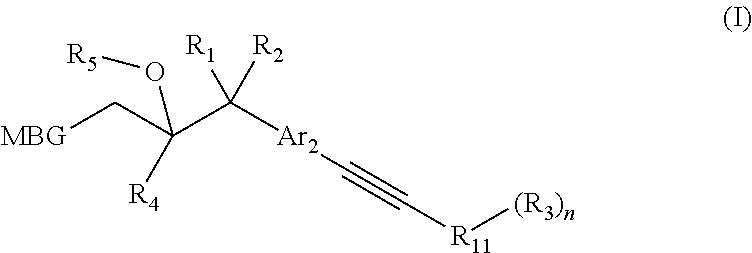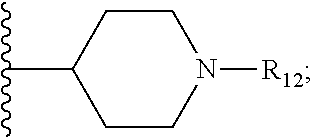Metalloenzyme inhibitor compounds
a technology of enzyme inhibitors and compounds, applied in the direction of antibacterial agents, drug compositions, metabolic disorders, etc., can solve the problem of dramatic decrease in enzyme activity, and achieve the effect of better potency and selectivity
- Summary
- Abstract
- Description
- Claims
- Application Information
AI Technical Summary
Benefits of technology
Problems solved by technology
Method used
Image
Examples
example 1
2-(2,4-Difluorophenyl)-1,1-difluoro-1-(5-(phenylethynyl)pyridin-2-yl)-3-(1H-tetrazol-yl)propan-2-ol (1)
[0552]To a suspension of copper powder (2.68 g, 42.2 mmol) in DMSO (35 mL) was added ethyl bromodifluoroacetate (2.70 mL, 21.10 mmol), and the mixture was stirred for 1 h at RT. 2,5-Dibromopyridine (2.50 g, 10.55 mmol) was then added and continued stirring for 15 h at RT. The reaction was quenched with aqueous NH4Cl and extracted with DCM (3×25 mL). The combined organic layers were washed with water, washed with brine, dried over anhydrous Na2SO4, and concentrated under reduced pressure to afford crude product mixture which upon column purification using EtOAc / hexane afforded the ethyl ester intermediate (2.40 g, 8.57 mmol, 81%) as a pale yellow oil. 1H NMR (500 MHz, CDCl3): δ 8.71 (s, 1H), 8.00 (d, J=9.0 Hz, 1H), 7.64 (d, J=9.0 Hz, 1H), 4.42-4.35 (m, 2H), 1.39-1.31 (m, 3H).
[0553]To a stirred solution of 2,4-difluoro-bromobenzene (1.65 g, 8.57 mmol) in diethyl ether (10 mL) was add...
example 2
[0558]
1-(5-((4-Chlorophenyl)ethynyl)pyridin-2-yl)-2-(2,4-difluorophenyl)-1,1-difluoro-3-(1H-tetrazol-1-yl)propan-2-ol (2)
[0559]To a stirred solution of compound D (100 mg, 0.231 mmol) in THF (5 mL) were added 4-chloro phenyl acetylene (47 mg, 0.345 mmol) followed by Pd(PPh3)2Cl2 (16 mg, 0.023 mmol), CuI (4.4 mg, 0.023 mmol) and diisopropyl ethylamine (0.08 mL, 0.462 mmol) at RT under argon atmosphere. The resulting reaction mixture was stirred for 16 h at reflux temperature under argon atmosphere. The progress of the reaction was monitored by TLC and LC-MS. The reaction mixture was cooled to RT, filtered through a pad of celite and filtrate was concentrated under reduced pressure. The obtained residue was diluted with water (15 mL) and extracted with ethyl acetate (4×30 mL). The combined organic layer was washed with water (10 mL), dried over anhydrous Na2SO4 and concentrated under reduced pressure to afford the crude product. The crude product was purified by prep HPLC (mobile phas...
example 3
[0560]
2-(2,4-Difluorophenyl)-1,1-difluoro-1-(5-((4-fluorophenyl)ethynyl)pyridin-2-yl)-3-(1H-tetrazol-1-yl)propan-2-ol (3)
[0561]To a stirred solution of compound D (250 mg, 0.578 mmol) in DMF (5 mL) were added 4-fluoro phenyl acetylene (104 mg, 0.868 mmol) followed by TPP (15 mg, 0.0578 mmol), CuI (11 mg, 0.0578 mmol) and Et3N (16 mL) at RT and purged with argon for a period of 20 min. To the resulting reaction mixture was added Pd(PPh3)2Cl2 (40 mg, 0.0578 mmol), again purged with argon for 20 min and stirred at RT. After 16 h, only 0.87% conversion was observed by LC-MS; the reaction mixture was then slowly heated to 60° C. and stirred for 6 h. After 6 h, the reaction mixture was cooled to RT, filtered through a pad of celite and filtrate was concentrated under reduced pressure. The obtained residue was diluted with water (50 mL) and extracted with ethyl acetate (3×40 mL). The combined organic layer was washed with water (2×15 mL), dried over anhydrous Na2SO4 and concentrated under ...
PUM
| Property | Measurement | Unit |
|---|---|---|
| enantiomeric excess | aaaaa | aaaaa |
| enantiomeric excess | aaaaa | aaaaa |
| enantiomeric excess | aaaaa | aaaaa |
Abstract
Description
Claims
Application Information
 Login to View More
Login to View More - R&D
- Intellectual Property
- Life Sciences
- Materials
- Tech Scout
- Unparalleled Data Quality
- Higher Quality Content
- 60% Fewer Hallucinations
Browse by: Latest US Patents, China's latest patents, Technical Efficacy Thesaurus, Application Domain, Technology Topic, Popular Technical Reports.
© 2025 PatSnap. All rights reserved.Legal|Privacy policy|Modern Slavery Act Transparency Statement|Sitemap|About US| Contact US: help@patsnap.com



